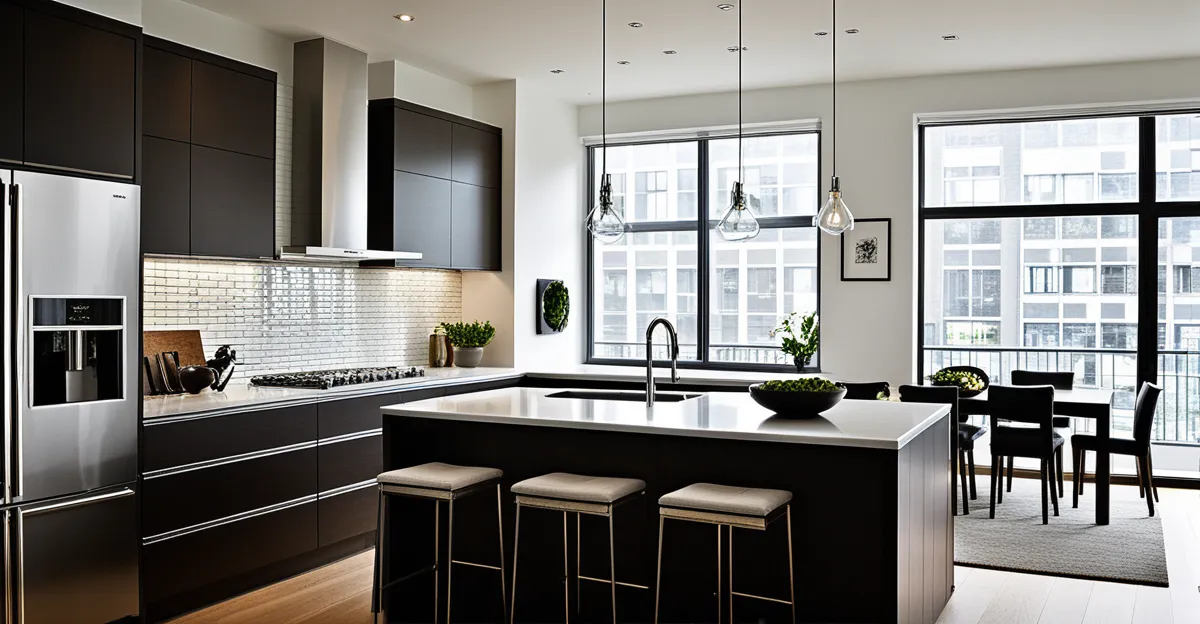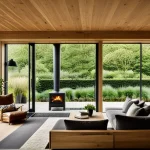Impact of Urban Living on Home Design Choices
Urban living brings unique challenges that shape urban home design profoundly. Space constraints in cities demand homes that prioritise efficiency without sacrificing comfort. Unlike suburban or rural settings, where ample square footage often allows for sprawling layouts, city homes must adapt to limited footprints. This adaptation results in a focus on space optimisation, making every inch count.
City dwellers often confront noise and privacy issues, pushing designers toward solutions that mitigate these effects while maintaining a sense of openness. High-rise buildings and close neighbourhoods influence priorities, leading to choices that favour soundproofing and discrete layouts. Moreover, urban lifestyles, characterized by fast pace and multifunctional needs, require homes that support dynamic daily routines.
This might interest you : How Can You Make Your UK Living Space More Sustainable?
The effects of urban living shape design to emphasise sleek, contemporary aesthetics with minimal clutter, enabling functionality and style harmoniously. In contrast, suburban homes might place higher value on outdoor space, while rural designs often integrate natural elements extensively. Recognizing these urban living effects fosters a more responsive and practical approach to city home adaptation, ensuring that homes meet the distinct demands of their bustling environments.
Maximising Space Efficiency in Urban Homes
Space constraints define urban apartment layouts, making small space design a critical skill for city dwellers. Effective space-saving solutions often start with thoughtful organisation. For instance, placing storage in underused nooks or utilising vertical space maximises room without crowding it.
Also read : How Can You Incorporate Sustainable Living Practices into Your UK Home Decor?
Multifunctional furniture is essential in urban home design. Pieces such as fold-away beds, extendable tables, and built-in shelves serve dual purposes, reducing clutter and increasing utility. These elements contribute to a flexible living environment that adapts to various daily needs—a key aspect of city home adaptation.
Visual order can also be achieved with open shelving and strategic furniture placement that creates clear pathways and zones within compact rooms. This approach improves flow and makes even limited areas feel more spacious and inviting.
In sum, mastering space efficiency in urban living hinges on combining functional furniture with smart organisational strategies. These enable residents to enjoy a balanced, comfortable lifestyle despite the inherent challenges of limited square footage. Embracing these principles helps transform tight quarters into harmonious, highly livable homes tailored for bustling city life.
Privacy and Noise Management in Urban Settings
Urban living demands effective urban privacy solutions due to close building proximity and crowded neighbourhoods. To enhance privacy, residents often use frosted glass, heavy curtains, or room dividers, which create personal zones without compromising natural light. Another common strategy involves strategic window placement, reducing direct sightlines into homes.
Noise reduction is a critical aspect of improving home comfort in cities. Double-glazed windows, acoustic panels, and insulated walls serve as primary barriers against city noise. White noise machines can further mask ambient sounds, helping maintain tranquility. Designers balance the need for openness with seclusion by incorporating soundproof materials in shared walls and floors while using open layouts inside to preserve a sense of spaciousness.
These urban privacy solutions and noise management techniques work in tandem to create calm retreats amid bustling environments. They address key urban living effects—where both visual and auditory privacy are constantly challenged. Through thoughtful design choices, city home adaptation achieves greater comfort without sacrificing the airy, open feel demanded by modern lifestyles.
Popular Urban Design Trends
Urban living effects have driven a marked shift toward minimalism in contemporary home design. This trend echoes the need for uncluttered, efficient spaces where every item serves a purpose. Minimalism complements city home adaptation by emphasising clean lines and simple palettes, creating a calming backdrop to hectic urban life.
A key feature of popular urban interior trends is the use of multifunctional decor and convertible furniture. Think sofa beds, nesting tables, and storage ottomans. These pieces enhance flexibility, helping residents adapt spaces quickly for work, leisure, or socialising while addressing spatial limitations typical of urban apartments.
Smart technology integration also defines modern city decor. Automated lighting, smart thermostats, and app-controlled devices improve energy efficiency and convenience. Innovative storage solutions, such as built-ins or modular units, blend seamlessly with minimalist aesthetics while addressing practical needs.
Together, these trends respond directly to urban living effects by combining style, function, and adaptability. They reflect a sophisticated approach to making small, dense living environments comfortable, efficient, and visually appealing in the bustling city context.
Expert Tips for Urban Home Comfort and Style
Adopting effective urban home tips can transform compact city spaces into stylish, comfortable retreats. Interior design experts emphasise creative use of colour and lighting to visually expand small rooms. Light, neutral palettes combined with layered lighting—such as recessed fixtures and adjustable lamps—enhance brightness, creating an airy atmosphere and reducing the feeling of confinement common in city home adaptation.
Materials and finishes play a vital role in urban settings. Durable, easy-to-clean surfaces like matte ceramics or treated wood withstand daily wear while maintaining aesthetic appeal. Reflective or translucent elements amplify natural light, further opening up spaces without cluttering them.
Maximising comfort without sacrificing style involves balancing ergonomic furniture with sleek design. Experts recommend modular seating and flexible layouts that support diverse urban lifestyles while preserving flow and openness. Incorporating greenery and soft textiles also softens modern city interiors, making them inviting despite spatial constraints.
Together, these strategies address urban living effects thoughtfully, fostering homes that feel spacious, welcoming, and tailored to the dynamic rhythm of city life. Applying such expert insights helps residents confidently navigate the unique challenges of living in dense urban environments.







